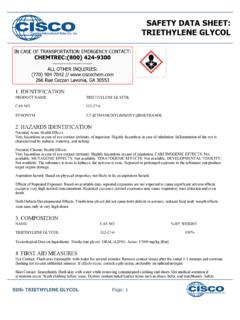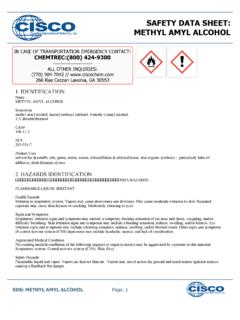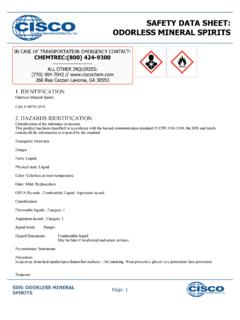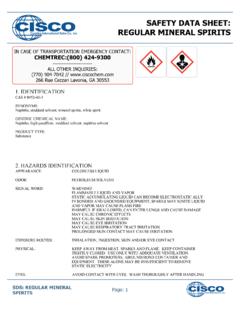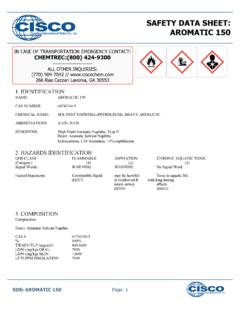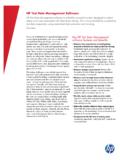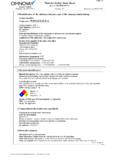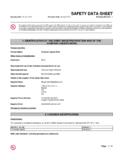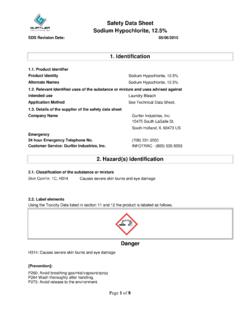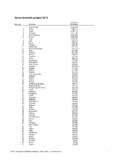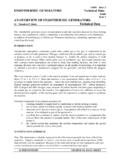Transcription of SAFETY DATA SHEET: AROMATIC 200 - …
1 SAFETY data sheet : AROMATIC 200. IN CASE OF TRANSPORTATION EMERGENCY CONTACT: CHEMTREC:(800) 424-9300. ----------------------- ALL OTHER INQUIRIES: (770) 904-7042 // 266 Rue Cezzan Lavonia, GA 30553. 1. IDENTIFICATION. Product Name: AROMATIC 200. Synonym: Solvent Naphtha (petroleum) Heavy arom Cas No: 64742-94-5. 2. HAZARDS IDENTIFICATION. Classification of the substance or mixture Classification (GHS-US). Carcinogenicity Category 2. Specific target organ toxicity (single exposure) Category 3 - Narcotic effects Specific target organ toxicity (single exposure). Category 3 - Respiratory irritation Specific target organ toxicity (single exposure) Category 1. Specific target organ toxicity (single exposure) Category 2. Specific target organ toxicity (repeated exposure) Category 1. Specific target organ toxicity (repeated exposure) Category 2. Aspiration hazard Category 1.
2 Signal word (GHS-US). DANGER. Hazard statements (GHS-US). May be fatal if swallowed and enters airways May cause respiratory irritation May cause drowsiness or dizziness Suspected of causing cancer Causes damage to organs (blood). May cause damage to organs (eye). Causes damage to organs (eye) through prolonged or repeated exposure May cause damage to organs (lung, nose) through prolonged or repeated exposure Precautionary statements (GHS-US). : Obtain special instructions before use. Do not handle until all SAFETY precautions have been read and understood. Do not breathe gas, mist, spray, vapors. Wash hands, forearms and face thoroughly after handling. Do not eat, drink or smoke when using this product. Use only outdoors or in a well-ventilated area. Wear eye protection, flame retardant protective clothing, impermeable protective gloves. If swallowed: Immediately call doctor, poison center.
3 Do NOT induce vomiting. If inhaled: Remove person to fresh air and keep comfortable for breathing. Specific treatment (see Section of SDS or information on this label). SDS: AROMATIC 200 Page: 1. If exposed or concerned: Get medical advice/attention. Get medical advice/attention if you feel unwell. Store in a well-ventilated place. Keep container tightly closed. Store locked up. Dispose of contents and container in accordance with all local, regional, national and international regulations. Hazards not otherwise classified Other hazards not contributing to the classification Product can accumulate electrostatic charges that may cause fire by electrical discharges. Additional information Based on conditions common to industrial workplace use of this product May cause mild eye irritation. May cause mild skin irritation. 3. COMPOSITION. MIXTURE. NAME CAS NO % BY WEIGHT.
4 AROMATIC Hydrocarbons (C11-C14) - 50-85. Naphthalene 91-20-3 5-20. AROMATIC Hydrocarbons (C10). not including naphthalene - 5-15. AROMATIC Hydrocarbons (C15-C16) - 5-15. 4. FIRST AID MEASURES. Description of first aid measures First-aid measures general Never give anything by mouth to an unconscious person. If you feel unwell, seek medical advice (show the label where possible). Suspected of causing cancer. First-aid measures after inhalation Remove victim to fresh air and keep at rest in a position comfortable for breathing. If breathing is difficult, give oxygen. If breathing stops, give artificial respiration. First-aid measures after skin contact Remove affected clothing and wash all exposed skin area with mild soap and water, followed by warm water rinse. First-aid measures after eye contact Rinse immediately with plenty of water. Obtain medical attention if irritation persists.
5 First-aid measures after ingestion Rinse mouth. Do NOT induce vomiting. Immediately call a poison center or doctor/physician. Most important symptoms and effects, both acute and delayed Symptoms/injuries after inhalation: May cause respiratory irritation. Symptoms/injuries after ingestion: May be fatal if swallowed and enters airways. Indication of any immediate medical attention and special treatment needed Treat symptomatically. 5. FIRE FIGHTING MEASURES. Extinguishing media SDS: AROMATIC 200 Page: 2. Suitable extinguishing media Foam. Dry powder. Carbon dioxide. Water spray. Sand. Unsuitable extinguishing media : Do not use a heavy water stream. Special hazards arising from the chemical Fire hazard Combustible liquid. Explosion hazard May form flammable/explosive vapor-air mixture. Advice for firefighters Firefighting instructions Use water spray or fog for cooling exposed containers.
6 Exercise caution when fighting any chemical fire. Prevent fire-fighting water from entering environment. Protection during firefighting Do not enter fire area without proper protective equipment, including respiratory protection 6. ACCIDENTAL RELEASE MEASURES. Personal precautions, protective equipment and emergency procedures Emergency procedures for non-emergency personnel: Evacuate unnecessary personnel Emergency procedures for emergency responders: Ventilate area Methods and material for containment and cleaning up For containment Dike for recovery or absorb with appropriate material. Do not contaminate ground and surface water Methods for cleaning up Soak up spills with inert solids, such as clay or diatomaceous earth as soon as possible. Collect spillage. Store away from other materials. 7. HANDLING AND STORAGE. Precautions for safe handling Additional hazards when processed Handle empty containers with care because residual vapors are flammable.
7 Keep away from heat, sparks, open flames, hot surfaces. - No smoking. Precautions for safe handling Wash hands and other exposed areas with mild soap and water before eating, drinking or smoking and when leaving work. Provide good ventilation in process area to prevent formation of vapor. No bare lights. No smoking. Obtain special instructions before use. Do not handle until all SAFETY precautions have been read and understood. Avoid breathing vapors, mist. Use only outdoors or in a well-ventilated area. Conditions for safe storage, including any incompatibilities Technical measures Proper grounding procedures to avoid static electricity should be followed. All efforts should be made to prevent any leaks or spills. Storage tanks should be engineered to prevent contact with water resources, as this material could contaminate the water resources. Surface spills can reach groundwater through porous soil or cracked surfaces.
8 The storage tanks should be monitored regularly for leaks. Where spills or leaks are possible, a comprehensive response plan should be developed and implemented. Storage conditions Keep only in the original container in a cool, well ventilated place away from : Direct sunlight, flames, heat sources, sparks. Keep in fireproof place. Keep container tightly closed. SDS: AROMATIC 200 Page: 3. Incompatible products Strong bases. Strong acids. Incompatible materials Sources of ignition. Direct sunlight. Heat sources. 8. EXPOSURE CONTROLS AND PERSONAL PROECTION. Occupational Exposure Limits Naphthalene (91-20-3). USA ACGIH ACGIH TWA (ppm) 10 ppm USA ACGIH ACGIH STEL (ppm) 15 ppm USA OSHA OSHA PEL (TWA) (mg/m3) 50 mg/m3. USA OSHA OSHA PEL (TWA) (ppm) 10 ppm EXPOSURE CONTROLS. Appropriate engineering controls Ensure adequate ventilation Personal protective equipment Avoid all unnecessary exposure.
9 Hand Protection Impermeable protective gloves. Choosing the proper glove is a decision that depends not only on the type of material, but also on other quality features, which differ for each manufacturer. Gloves should be discarded and replaced if there is any indication of degradation or chemical breakthrough. The exact break trough time has to be found out by the manufacturer of the protective gloves and has to be observed. Eye Protection Chemical goggles or SAFETY glasses. Skin and body protection Wear fire/flame resistant/retardant clothing. Respiratory protection An approved organic vapor respirator/supplied air or self-contained breathing apparatus must be used when vapor concentration exceeds applicable exposure limits. Other Information Do not eat, drink or smoke during use. 9. PHYSICAL AND CHEMICAL PROPERTIES. Information on basic physical and chemical properties Physical state Liquid Color Straw Odor Characteristic Odor threshold No data available pH Not applicable SDS: AROMATIC 200 Page: 4.
10 Relative evaporation rate (butyl acetate=1) No data available Melting point No data available Freezing point No data available Boiling point 217 - 296 C. Flash point >=95 C Closed cup Auto-ignition temperature No data available Decomposition temperature No data available Flammability (solid, gas) No data available Vapor pressure <1 mm Hg @20 C. Relative vapor density at 20 C Air = 1. Relative density - Solubility Water - Negligible Log Kow No data available Viscosity, kinematic <20 cSt at 40 C. Viscosity, dynamic No data available Explosive limits No data available Other information VOC content 100%. 10. STABILITY AND REACTIVITY. Reactivity Combustible liquid. Chemical stability Stable at ambient temperature and under normal conditions of use. Possibility of hazardous reactions Under normal conditions of storage and use, hazardous polymerization will not occur.
